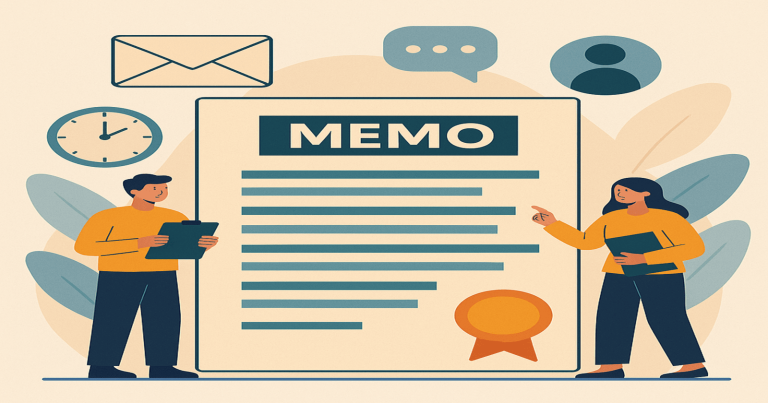In business, law, and offices, people use short written records to share important points. These written records are called memorandum. You may also hear the word “memo.” A memorandum is a short, clear, and official note used for communication inside a company or between departments. It is not like a long letter. It talks about one topic in a clear way. A memorandum helps record and send information that is short but important. It can give instructions, share updates, or state agreements. For example, when a manager wants to inform staff about a new rule, they write a memorandum. In companies and legal settings, memos act as proof of what was said or decided. The format is fixed, and the tone is simple and formal.
What Is a Memorandum? — Basic Meaning and Purpose
A memorandum is a short written message that shares important information. People use it in offices, schools, companies, and even government work. It is more formal than a simple note but shorter than a letter. You use a memo to tell others about updates, reminders, new rules, or decisions.
Why Do We Use a Memorandum?
People use memorandums because they want a quick and clear way to share something serious. A memo can give instructions, ask for action, report a change, or explain a new plan. Since it is written, it can be kept as a record. If any problem comes up later, you can check the memo.
You can use a memo for:
- Announcing meetings or changes in policy
- Sharing progress reports
- Giving instructions to team members
- Communicating between departments
- Recording decisions or agreements
In simple words, the purpose of a memorandum is to communicate within an organization clearly, quickly, and formally. The memo helps reduce confusion because it gives facts in writing.
Characteristics of a Good Memorandum
A good memorandum must be short, clear, and direct. It should only talk about one topic. If your memo is neat and correct, people will read and follow it.
- Clarity: A good memo uses short sentences and simple words. Everyone in the office should understand the message easily. The goal is to avoid confusion and make the purpose clear from the start.
- Formal Tone: The language of a memorandum is formal and respectful. Even if the memo is about a small matter, it must sound serious. This is because it represents the organization.
- One Topic Focus: A memo should only cover one issue at a time. This helps the reader focus and act correctly. Mixing topics in one memo may confuse readers and delay action.
- Well-Defined Header: Every memo starts with a header. It includes the names of sender and receiver, date, and subject. This format helps organize the document and improves readability.
- Action-Oriented Message: A good memo ends with what the reader should do. It must clearly explain what is expected. This saves time and ensures work moves forward.

Types of Memorandum — Based on Use and Purpose
There are different types of memorandums used in daily work. Each one serves a different purpose. These types help solve specific problems or share certain updates.
- Business Memorandum: This memo is used within a company to share updates, instructions, or reminders. It connects departments and helps in planning. Business memos help managers control workflow by keeping everyone informed of goals or changes.
- Legal Memorandum: Lawyers and legal teams use this memo to explain case details or laws. It includes facts, analysis, and legal advice. These memos are used in law firms, courts, and corporate legal departments to support decision-making.
- Memorandum of Understanding (MoU): An MoU is a formal document that shows an agreement between two or more parties. It is not a legal contract, but it confirms shared plans. Organizations use MoUs when starting new partnerships or projects.
- Interoffice Memorandum: This type of memo is exchanged between teams or employees in the same company. It keeps everyone aware of internal matters like equipment issues, building repairs, or staff movements. It is widely used for daily updates.
- Memorandum for Record (MFR): This memo is used to keep a record of events, decisions, or meetings. It is not always shared but saved for future reference. These memos are very helpful in documenting verbal discussions.
Format of a Memorandum — How to Write One Correctly
Writing a memo needs a set format. This format keeps it simple and useful. The person reading it can find the message quickly.
- Header Elements: Begin with the following fields: To, From, Date, and Subject. These tell the reader who is involved and what the memo is about. Without this, the memo may seem incomplete or confusing.
- Opening Statement: Start with one or two lines explaining why you wrote the memo. This helps the reader get the purpose instantly. For example, you may write, “This memo is to inform you about the new office hours.”
- Main Body: In this section, give details about the topic. Break the information into small paragraphs. Use lists if needed. Do not mix other topics to keep the reader focused.
- Closing and Call to Action: End the memo with what the reader should do next. It could be attending a meeting, following new rules, or responding with feedback. A clear call to action improves follow-up.
- Optional Signature: Not all memos need a signature. But for official matters, you can add your name or digital sign. This adds responsibility and helps others know who sent it.
Difference Between Memorandum and Letter
Many students and workers think both are the same. But a letter and memorandum are different in use, style, and format. Let’s understand these clearly.
- Purpose of Use: A memorandum is for communication within the company. A letter can be for both inside and outside the organization. Memos are informal in setup but still formal in tone.
- Format and Structure: A memo has a fixed format with To, From, Date, and Subject. A letter includes sender and receiver addresses, greeting, body, and closing. Letters follow a more detailed layout.
- Tone and Language: Memos are direct and use formal, clear language. Letters can be formal or informal depending on the reader. Memos avoid extra words and only mention key facts.
- Length and Content: A memo is usually short and focused on one point. A letter can be longer and may cover multiple topics. Memos use short paragraphs or bullet points to improve readability.
- Use of Signature: Memos may or may not include a signature. Letters usually end with a signature or name block. This makes letters more personal or legally sound.
| Feature | Memorandum | Letter |
| Use | For internal office use | For both internal and external use |
| Format | Short, fixed format | Long, flexible format |
| Tone | Formal and direct | Formal or informal |
| Subject Focus | One main subject only | May cover more than one subject |
| Header Elements | To, From, Date, Subject | Sender Address, Receiver Address, Date, Salutation |
| Signature | Not always needed | Usually needed |
Uses of Memorandum in Daily Office Life
People use memos for many small and big tasks. In offices, memos save time and reduce speaking errors. They help keep clear records.
- Policy Announcements: Managers use memos to share new policies or updates. This keeps staff aware of rules and expectations. Written messages help reduce misunderstandings.
- Meeting Invitations: A memo can invite people to attend meetings. It includes the date, time, place, and agenda. Everyone gets the same information and prepares on time.
- Work Instructions: Supervisors use memos to assign tasks or give directions. Employees can read and follow them easily. It also helps in tracking deadlines and progress.
- Record Keeping: Memos serve as proof of communication. If there is any doubt later, people can check the old memo. This is important in audits and reports.
- Daily Reminders: Memos are used to remind teams of upcoming events or duties. It avoids last-minute confusion. These small notes improve team coordination.
Advantages of Memorandum in Communication
Memos give many benefits to offices, staff, and managers. These small notes make work easy and smooth. Here’s how they help:
- Fast Delivery: Memos are quick to write and send. You can type and share them by hand or email. This saves time on busy workdays.
- Formal Record: Memos provide written proof of a message. You can store them and refer to them later. This protects against forgetfulness or false claims.
- Focused Content: A memo discusses one topic clearly. This makes the reader understand and act faster. It keeps communication clean and helpful.
- Supports Teamwork: Memos improve internal communication. They connect different teams and roles. Everyone feels informed and part of the process.
- Low Cost Communication: You don’t need envelopes, stamps, or printing. Memos can be digital or handwritten. It saves money and reduces waste.
Memorandum FAQs
Q1. What is a memorandum in simple words?
A memorandum is a short written note. People use it in offices to share important updates or instructions.
Q2. Why do companies use memorandums?
They use them to save time, stay clear, and keep records. It helps everyone stay updated and avoid confusion.
Q3. What are the main parts of a memorandum?
A memo has To, From, Date, Subject, and the body. Some also include signatures at the end.
Q4. Is a memo only used in business?
No. People use memos in schools, offices, law firms, and even in government departments.
Q5. How is a memo different from a letter?
A memo is short and used inside the office. A letter is longer and can go to people outside the office too.


